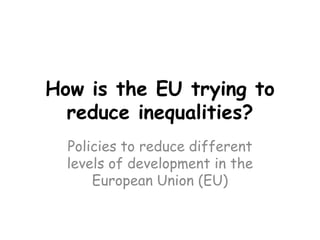
How is the eu trying to reduce inequalities
- 1. How is the EU trying to reduce inequalities? Policies to reduce different levels of development in the European Union (EU)
- 2. Political steps to reduce inequalities are: 1. The Common Agricultural Policy (CAP) This includes a system of subsidies (payments) paid to EU farmers to grow certain products. When world food prices are low, the EU buys the produce and guarantees the farmers a reasonable income. A high import tax is placed on foreign produce from outside the EU. Aim is for people to buy from the EU. All of these things improve the quality of life for farmers in EU
- 3. 2. Urban Community Initiative Many Europeans live on urban areas. More opportunities, etc. BUT, all cities have problem areas. So, money is given to certain EU cities to create jobs, reduce crime and increase the area of green space. SUSTAINABLE development through regeneration. E.g. new ring road. Reduces traffic congestion through town, cutting pollution levels and adding cycle paths too.
- 4. 3. Structural funds These support poorer regions of Europe and improve employment opportunities, reduce discrimination and improve transport links. Regions whose GDP is less than 75% of the EU average are targeted. The aim is to get all members of the EU to a similar level of development. (reducing inequalities)